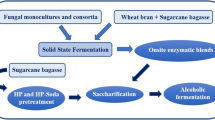Abstract
Phanerochœte chrysosporium strain H-298 grown on sugarcane bagasse pith, a lignocellulosic residue, is proposed as a bioremediation agent for aromatic contaminated soils. To investigate the use of pith for the development of a fungal inoculum, the effect of culture conditions on fungus survival and microbial respiration under solid fermentation were studied. Microbial respiration, estimated from the CO2 evolution rates, was maintained relatively high at low aeration conditions. High respiration occurred in cultures with 2,2-dimethylsuccinate added and without buffers, but not in those with acetate, succinate and phosphate buffers. It was observed that the culture was autobuffered at pH 4.5, due to acetic acid release, and that moisture content increased from 60 to 70%; these conditions were appropriate for fungal cultivation. CO2 evolution rates and fluorescence analysis showed that fungal survival was maintained through 18 d.
Similar content being viewed by others
References
Agosin E., Odier E.: Solid-state fermentation, lignin degradation and resulting digestibility of wheat straw fermented by selected white-rot fungi.Appl. Microbiol. Biotechnol. 21, 397–403 (1985).
Boominathan K., Reddy C.A.: Fungal degradation of lignin: biotechnological applications, pp. 763–782 inHandbook of Applied Mycology, Vol. 4 (D.K. Arora, R.P. Elander, K.G. Mukerji, Eds). Marcel Dekker, New York 1992.
Bumpus J.A.: White rot fungi and their potential use in soil bioremediation process, inSoil Biochemistry (J.-M. Bollac, Ed.). Marcel Dekker, New York-Basel-Hong Kong 1993.
Field J.A., Jong E., Feijoo-Costa G., De-Bont J.A.M.: Screening for ligninolytic fungi applicable to the biodegradation of xenobiotics.TIBTECH 11, 44–49 (1993).
Kirk T.K., Tien M., Kersten P.J.: Lignin peroxidase from fungi:Phanerochœte chrysosporium.Methods Enzymol. 188, 159–171 (1990).
Klomp E., Durán De-Bazua C.: Tecnologías más limpias, un acercamiento al mejoramiento de la productividad y a la protección del ambiente para ingenios azucareros, mexicanos. Universidad Nacional Autónoma de México/United Nations Industrial Development Organization 1995.
Lang E., Nerud F., Novotná E., Zadrazil F., Martens R.: Production of ligninolytic exoenzymes and14C-pyrene mineralization byPleurotus sp. in lignocellulose substrate.Folia Microbiol. 41, 489–493 (1996).
Mitchel D.A.: Biomass determination in solid-state fermentation, pp. 53–63 inSolid Substrate Cultivation (H.W. Doelle, D.A. Mitchel, Rolz C.E., Eds.). Elsevier Sci. Publ., London-New York 1992.
Mitchel D.A., Lonsane B.K.: Definition characteristics and potential, pp. 1–10 inSolid Substrate Cultivation (H.W. Doelle, D.A. Mitchel, Rolz C.E., Eds). Elsevier Sci. Publ., London-New York 1992.
Morgan P., Cooper C.J., Battersby N.S., Lee S.A., Lewis S.T., Machin T.M., Graham S.C., Watkinson R.J.: Automated image analysis method to determine fungal biomass in soils and on solid matrices.Soil Biol. Biochem. 23, 609–616 (1991).
Pandey A.: Recent process development in solid-state fermentation.Process Biochem. 27, 109–117 (1992).
Raimbault M., Alazard D.: Culture method to study fungal growth in solid fermentation.Eur. J. Appl. Microbiol. 9, 199–209 (1980).
Reddy C.A.: The potential for white-rot fungi in the treatment of pollutants.Curr. Opin. Biotechnol. 6, 320–328 (1995).
Ríos-Leal E., Rodríguez-Vázquez R., Galindo T.: Separation of phenolic compounds from sugarcane bagasse pith and their determination by HPLC.J. Wood Sci. Technol. 14, 369–382 (1994).
Rodríguez-Vázquez R., Areyzaga M., Parada A., Ríos-Leal E., Anguis-Terrazas C.: Isolation and characterization of lignin from rice hull.J. Sci. Food Agric. 62, 101–104 (1993).
Rodríguez-Vázquez R., Díaz-Cervantes D.: Effect of chemical solutions sprayed on sugarcane bagasse pith to produce single cell protein: physical and chemical analysis of pith.Biores. Technol. 47, 159–164 (1994).
Rojas-Avelizapa N.G.: Biodegradación de compuestos aromáticos contenidos en aguas de pulpeo porPhenorochœte chrysosporium. (In Spain) MSc Thesis.Centro de Investigación y de Estudios Avanzados del I.P.N. (México) 1995.
Rodríguez-Vázquez R., Villanueva-Ventura G., Ríos-Leal E.: Sugarcane bagasse pith dry pretreatment for single cell protein production.Biores. Technol. 39, 17–22 (1992).
TAPPI: Acid-insoluble lignin in wood and pulp (Standard method T222 os-74).Technical Association of Pulp and Paper Industries, Technology Park, Atlanta (GA, USA) 1989.
TAPPI: Extractive free material. Standard method T12 m-45 and T6 m-54.Technical Association of Pulp. and Paper Industries, Technology Park, Atlanta (GA, USA) 1984.
TAPPI: Holocellulose. Standard method T9M-54 and ASTM D1104-56.Technical Association of Pulp and Paper Industries, Technology Park, Atlanta (GA, USA) 1987.
Author information
Authors and Affiliations
Corresponding author
Rights and permissions
About this article
Cite this article
Rodríguez-Vázquez, R., Cruz-Córdova, T., Fernández-Sánchez, J.M. et al. Use of sugarcane bagasse pith as solid substrate forP. chrysosporium growth. Folia Microbiol 44, 213–218 (1999). https://doi.org/10.1007/BF02816245
Received:
Revised:
Issue Date:
DOI: https://doi.org/10.1007/BF02816245




